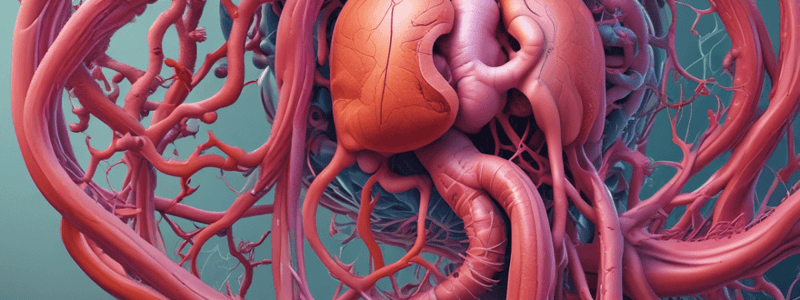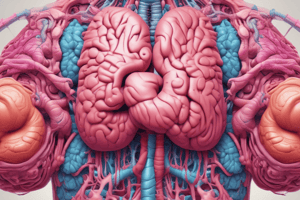Podcast
Questions and Answers
Match the following organs with their functions:
Match the following organs with their functions:
Liver = Production of plasma, energy, and bile Stomach = Digests and stores food Pancreas = Produces digestive juices and insulin Gall bladder = Stores and releases bile
Match the following body parts with their functions in the urinary system:
Match the following body parts with their functions in the urinary system:
Kidneys = Extract waste products and produce urine Ureters = Carry urine to the bladder Bladder = Receive and hold urine Urethra = Excrete urine to the outside
Match the following terms with their descriptions:
Match the following terms with their descriptions:
Small intestine = Absorb nutrients from digestion Large intestine = Collect solid wastes for excretion Rectum = Exit for wastes Urinary system = Removes waste products from the blood
Match the following systems with their main functions:
Match the following systems with their main functions:
Match the component of the respiratory system with its description:
Match the component of the respiratory system with its description:
Match the gas percentages with their corresponding location:
Match the gas percentages with their corresponding location:
Match the anatomical term with its function:
Match the anatomical term with its function:
Match the respiratory control location with its function:
Match the respiratory control location with its function:
Match the components of the respiratory system with their main functions:
Match the components of the respiratory system with their main functions:
Match the given terms with their locations in the body:
Match the given terms with their locations in the body:
Match the following medical terms with their definitions:
Match the following medical terms with their definitions:
Match the following terms with their abbreviations/acronyms:
Match the following terms with their abbreviations/acronyms:
Match the following medical conditions with their symptoms:
Match the following medical conditions with their symptoms:
Match the following body parts with their functions:
Match the following body parts with their functions:
Match the following emergency procedures with their purposes:
Match the following emergency procedures with their purposes:
Match the following medical terms with their related body parts/functions:
Match the following medical terms with their related body parts/functions:
Match the following terms with their definitions:
Match the following terms with their definitions:
Match the following medical terms with their descriptions:
Match the following medical terms with their descriptions:
Match the following medical conditions with their characteristics:
Match the following medical conditions with their characteristics:
Match the following medical procedures with their purposes:
Match the following medical procedures with their purposes:
Match the following anatomical structures with their functions:
Match the following anatomical structures with their functions:
Match the following medical emergencies with their descriptions:
Match the following medical emergencies with their descriptions:
Match the following medical terms with their definitions:
Match the following medical terms with their definitions:
Match the following first aid procedures with their descriptions:
Match the following first aid procedures with their descriptions:
Match the following terms with their medical conditions or procedures:
Match the following terms with their medical conditions or procedures:
Flashcards are hidden until you start studying




